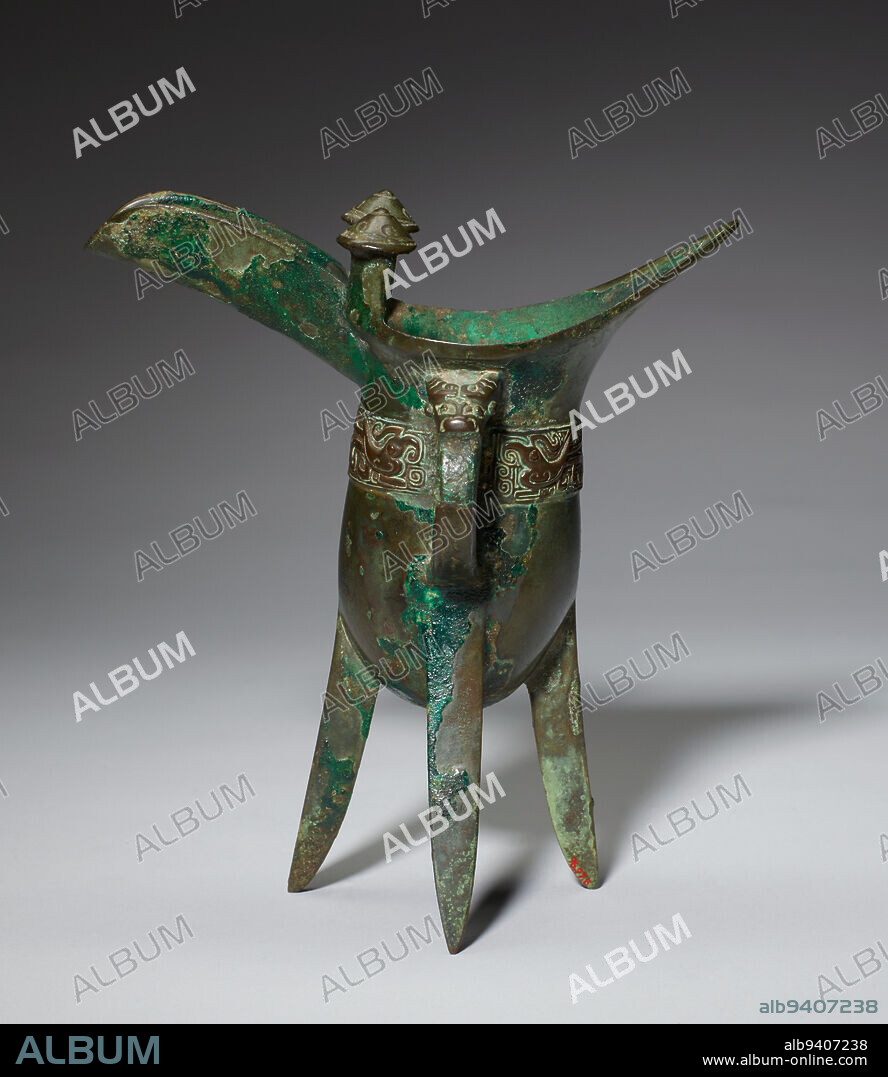alb9407238
Jue libation vessel, 11th century BCE, 7 3/8 × 6 7/16 × 3 1/2 in., 1.3 lb. (18.73 × 16.35 × 8.89 cm, 0.6 kg), Bronze, China, Western Zhou dynasty (c. 1046977 BCE), Jue are one of the earliest ceremonial bronze forms created by artists in the Erlitou culture (c. 20001600 BCE), the first known culture in China to employ advanced bronze technology. The prototype of the bronze jue is a pottery vessel known as gui, found in the late Neolithic Longshan culture (c. 25002000 BCE). A type of wine vessel, Jue flourished during the Shang (c. 16001406 BCE) and early Western Zhou (c. 1406977 BCE) dynasties but diminished in popularity after the midWestern Zhou period in the late 800s BCE. This jue, with its goblet-like body supported by tall blade-shaped legs, is typical of the early Western Zhou dynasty. Its long U-shaped spout is flanked by two capped posts, which are visually and physically balanced by a flaring winglike tail. The decoration on the band consists of two pairs of birds facing a taotie mask. The taotie is a composite animal. The two posts with umbrella-like caps are likely decorative.

|
Add to another lightbox |
|
Add to another lightbox |



Buy this image.
Select the use:

Caption:
Jue libation vessel, 11th century BCE, 7 3/8 × 6 7/16 × 3 1/2 in., 1.3 lb. (18.73 × 16.35 × 8.89 cm, 0.6 kg), Bronze, China, Western Zhou dynasty (c. 1046977 BCE), Jue are one of the earliest ceremonial bronze forms created by artists in the Erlitou culture (c. 20001600 BCE), the first known culture in China to employ advanced bronze technology. The prototype of the bronze jue is a pottery vessel known as gui, found in the late Neolithic Longshan culture (c. 25002000 BCE). A type of wine vessel, Jue flourished during the Shang (c. 16001406 BCE) and early Western Zhou (c. 1406977 BCE) dynasties but diminished in popularity after the midWestern Zhou period in the late 800s BCE. This jue, with its goblet-like body supported by tall blade-shaped legs, is typical of the early Western Zhou dynasty. Its long U-shaped spout is flanked by two capped posts, which are visually and physically balanced by a flaring winglike tail. The decoration on the band consists of two pairs of birds facing a taotie mask. The taotie is a composite animal. The two posts with umbrella-like caps are likely decorative.
Credit:
Album / quintlox
Releases:
Image size:
5202 x 5999 px | 89.3 MB
Print size:
44.0 x 50.8 cm | 17.3 x 20.0 in (300 dpi)
Keywords:
1.3 LB • 1046977 BCE • 11TH CENTURY BCE • 1406977 BCE • 16001406 BCE • 20001600 BCE • 25002000 BCE • ARTFORM: BRONZEWORK • ARTISTS • BAND CONSISTS • BIRDS FACING • BRONCE • BRONZE BRASS • BRONZE JUE • BRONZE • BRONZES • CHINA • CHINE • CHINESE • COMPOSITE ANIMAL • CULTURE • DECORATION • DECORATIONS • DECORATIVE • DIMINISHED • DYNASTIES • EARLIEST CEREMONIAL BRONZE FORMS CREATED • EARLY WESTERN ZHOU DYNASTY • EARLY WESTERN ZHOU • EMPLOY ADVANCED BRONZE TECHNOLOGY • ERLITOU CULTURE • FIRST • FLANKED • FLARING WINGLIKE TAIL • GOBLET-BODY SUPPORTED • GUI • JUE FLOURISHED • JUE LIBATION VESSEL • JUE • LATE 800S BCE • LATE NEOLITHIC LONGSHAN CULTURE • LONG U-SHAPED SPOUT • MIDWESTERN ZHOU PERIOD • PHYSICALLY BALANCED • POPULARITY • PORCELAIN • POTTERY VESSEL • PROTOTYPE • SHANG • TALL BLADE-SHAPED LEGS • TAOTIE MASK • TAOTIE • TWO CAPPED POSTS • TWO PAIRS • TWO POSTS • TYPE • TYPICAL • UMBRELLA-CAPS • VISUALLY • WESTERN ZHOU DYNASTY • WINE VESSEL


 Pinterest
Pinterest Twitter
Twitter Facebook
Facebook Copy link
Copy link Email
Email
